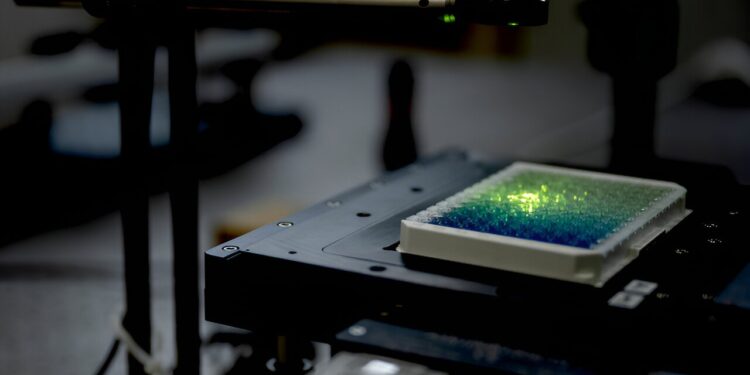No complicated technology is required to detect near-infrared fluorescence, as shown in this experimental setup. The nanotubes sit in the wells of the so-called well plate. Green light stimulates fluorescence. Credit: Ruhr-Universitaet-Bochum
The Fraunhofer Institute for Microelectronic Circuits and Systems IMS and Ruhr University Bochum, Germany, have developed a process that enables a new form of signal amplification for diagnostic testing. With the advanced use of single-walled luminescent carbon nanotubes in bioanalysis, testing procedures can be performed more sensitively, faster, and less expensively.
The sensors can be used for enzymatic processes. Their adaptability to different reaction conditions opens a wide range of applications for standard methods such as ELISA, short for Enzyme-linked Immunosorbent Assay.
The results were published on December 15, 2023 in Angewandte Chemie International Edition. They open up new possibilities for improving diagnostic procedures and saving detection agents.
Diagnostic limits can be improved with the luminous carbon sensor
Many diagnostic procedures use light to detect the amount of a particular substance. It may be a colored substance or a luminescent substance. Unfortunately, there are many background signals in the visible light range. To move the optical signal of a measurement into a better spectral range, the researchers used carbon tubes less than a nanometer in diameter. It’s about 100,000 times finer than a human hair.
The sensors emit near-infrared fluorescence, which is not visible to the human eye, and do not bleach. In addition, the fluorescence of the sensors is sensitive to their chemical environment due to a modification of their surface. This allows chemical reactions to be observed and reaction products to be detected as they interact with the nanotube.
The fluorescence of the nanotubes shifts the signal into the near-infrared range, which, combined with the high sensitivity of the nanotubes, results in a shift in the detection limit. This is important, for example, when disease markers are present at very low levels in an infection or disease such as cancer.
The ability to tailor nanotubes to different analytes opens a wide range of possibilities, including an increase in sensitivity. This gain in sensitivity allows for a potential change in detection limits, which can result in material and time savings in diagnostic processes. This innovative approach could significantly increase the efficiency of detection methods in medical diagnosis.
The group demonstrated that the new sensor principle works using the substrates p-phenylenediamine and tetramethylbenzidine for the horseradish peroxidase enzyme. “This enzyme is used in various biochemical detection methods,” explains Justus Metternich from Fraunhofer IMS.
“But in principle, the concept can be applied to all kinds of systems. For example, we also studied the enzyme β-galactosidase, which is of interest for diagnostic applications. With some modifications, it could also be used in bioreactions.”
In the future, the group plans to adapt the sensors to other applications. For example, depending on the application, sensors could be made more stable through so-called quantum defects. “This would be particularly advantageous if you not only want to measure in simple aqueous solutions, but also follow enzymatic reactions in complex environments with cells, in blood or in a bioreactor itself,” explains Sebastian Kruss, professor of chemistry physics at Ruhr University Bochum and head of the Attract Biomedical Nanosensors group at Fraunhofer IMS.
More information:
Justus T. Metternich et al, Signal amplification and near-infrared translation of enzymatic reactions by nanosensors, Angewandte Chemie International Edition (2023). DOI: 10.1002/anie.202316965
Powered by Ruhr-Universitaet-Bochum
Quote: New nanosensors make diagnostic procedures more sensitive (February 13, 2024) retrieved February 13, 2024 from
This document is subject to copyright. Apart from fair use for private study or research purposes, no part may be reproduced without written permission. The content is provided for information only.



